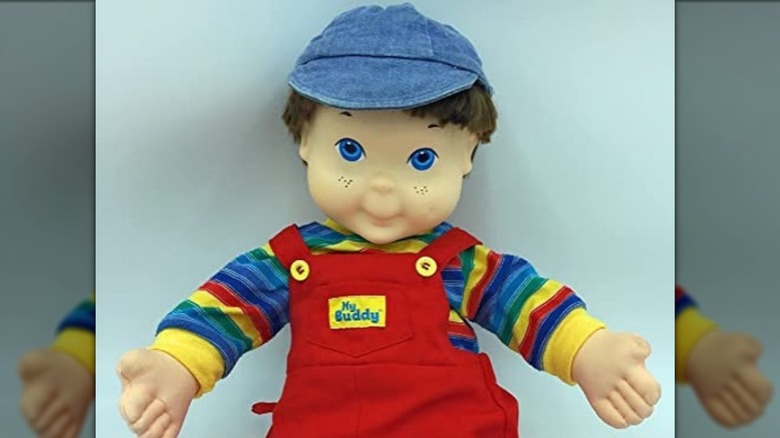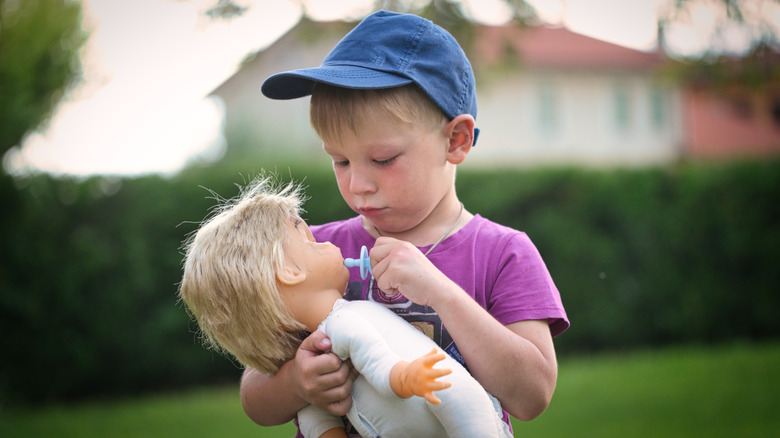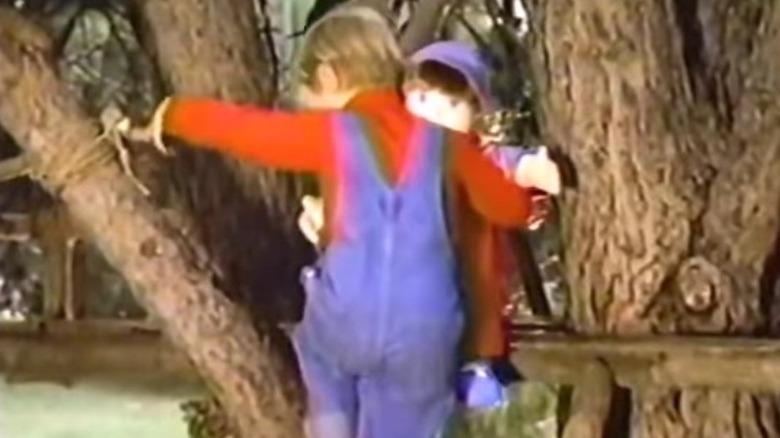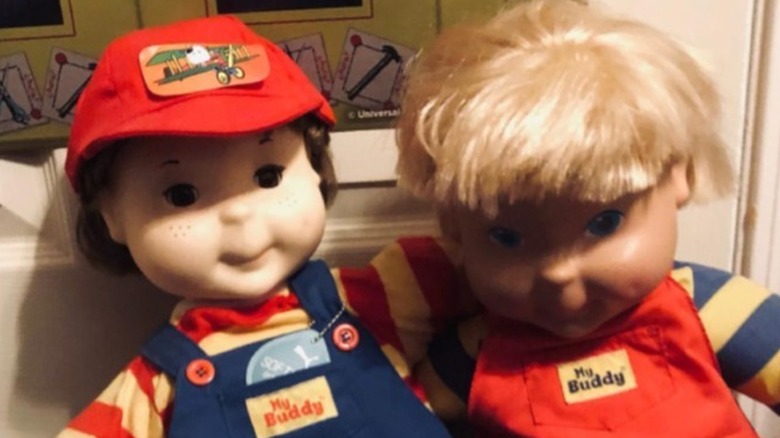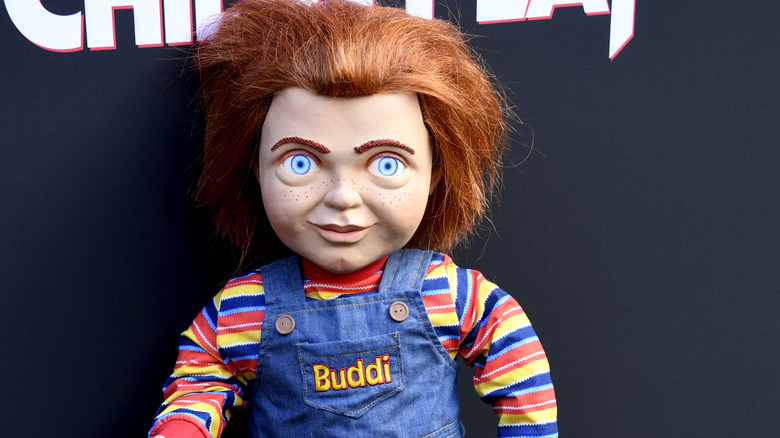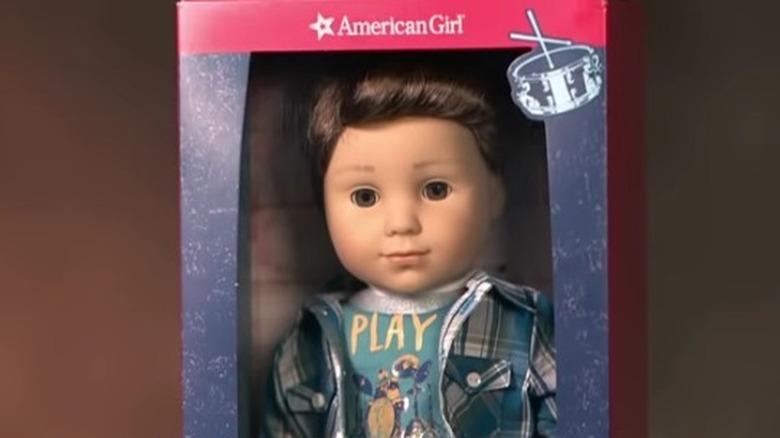What Happened To The My Buddy Doll?
In 1972, children's books author Charlotte Zolotow published her classic story "William's Doll," one of the first examinations of gender equality when it comes to expectations and support concerning kids and their toys. Per Zolotow's personal website, the book tells the story of a little boy named William who wants a doll to play with, a request that is treated with apprehension and concern by his parents, and scorn and derision from other kids, until his grandmother steps in and saves the day. She tells William's skeptical father that playing with a doll is a good thing because William can practice now and be a good father someday.
Zolotow noted that she was inspired to write the book by her own husband, who very much wanted children and was delighted when their son and daughter were born, "[b]ut even so, he had a hard time with the physical side of it. For instance, he never changed a diaper, and would leave the room when the baby was being changed. This is not a put-down of him: it was the custom of the time." Zolotow sought to normalize little boys playing with dolls. Her book struck a chord and was adapted into a short film as well as a song featured on the 1972 children's album "Free to Be ... You and Me." However, dolls for boys didn't go mainstream, and when Hasbro introduced their My Buddy doll 13 years later in 1985, it was an unusual and disruptive moment in the toy industry.
Dolls were selling well in the mid-1980s
When Hasbro decided to introduce My Buddy, a soft-bodied doll marketed to boys, the idea of boys playing with dolls was still so controversial that the company did careful research before releasing the doll to the public. A 1985 article in The New York Times noted that pre-market testing had come to include making sure that new toys fit what they referred to as "parental value patterns." Hasbro senior vice president of marketing Stephen Schwartz told the Times that they had decided to make My Buddy and market the doll to boys under 5 because "little boys have a soft side just like little girls." Nevertheless, Hasbro interviewed parents, particularly focusing on fathers in this instance, to ensure that they would be open to the idea of their own boy children playing with dolls in the first place.
Per the Times, dolls had once again become trendy after a long period of electronic toys taking over the market. Between 1983 and 1985, shipments of dolls and other traditional toys went up 111% and brought in $3.36 billion. Cabbage Patch Kid dolls had burst onto the scene and become such a hit that a shortage of the toys caused in-store riots during the 1985 Christmas season. If ever there was a time to experiment with marketing dolls to girls as well as boys, this was it.
My Buddy was an instant hit
Despite Hasbro's Steven Schwartz noting that children's soft sides had nothing to do with gender and that many kids, boys and girls alike, could enjoy playing with dolls, the My Buddy advertising campaign shied away from portraying little boys playing with My Buddy in a way that suggested nurturing or caretaking. Instead, the commercials presented a rough-and-tumble, ready-for-anything doll that little boys could take along on all their daily adventures. The catchy My Buddy song that played over the commercial (available on YouTube) inescapable during any sort of mid-'80s children's television programming included lyrics like "wherever I go he goes" and "My Buddy and me like to climb up a tree."
The commercial's story line features a little boy dressed nearly identically to the My Buddy doll, in matching overalls, which emphasizes that the relationship of the child to the doll is one of friendship rather than quasi-parenthood. My Buddy accompanies the kid as he, yes, climbs a tree as well as rides a Big Wheel and runs out of a clubhouse with a bunch of other boys. They also watch TV together, but this is the only quiet moment shown in the commercial — certainly nothing takes place that implies nurturing or caretaking.
'It's soft macho, but it's still macho'
My Buddy's advertising worked well. Per Mental Floss, like the television ads, the doll's advertising copy remained focused on the action-oriented possibilities for boys playing with Buddy, calling him "A little boy's special friend! Rough and tough, yet soft and cuddly." Stephen Schwartz may have mentioned to The New York Times that boys and girls both had "soft sides" that responded well to dolls, but in a quote taken by Mental Floss from an interview with The Boston Globe, "My Buddy is positioned as macho. It's soft macho, but it's still macho. We show them climbing up trees, riding their bikes. We didn't position it like a girl doll, soft and sweet."
The supposedly "macho" approach, combined with the still-iconic theme song, worked. Per toy book author Chris Byne, speaking to Campaign Live, "My Buddy had an amazing advertising campaign targeted to kids, so kids wanted it," says Byrne. "You can't underestimate the power of the marketing." By the end of 1985, My Buddy, which retailed for $25, came in eighth in the list of top 10 best selling toys of the year, with Cabbage Patch Kids taking the top spot.
Chucky spelled trouble for Buddy
My Buddy was so successful that Hasbro went on to introduce a companion doll, Kid Sister, intended for girls. Kid Sister's commercial also featured action-oriented play (the girl doll also got a ride on a Big Wheel) as well as more traditional activities like a tea party. My Buddy had worked its way so firmly into the pop culture landscape that it inspired a character that would go on to place its own indelible stamp upon American culture and actually harm My Buddy's image in the process. In 1988, per IMDb, United Artists released the horror movie "Child's Play," featuring a "Good Guy Doll" named Chucky who bears more than a passing resemblance to My Buddy, including a nearly identical overalls and striped shirt outfit. Chucky is possessed by soul of a serial killer and murderous chaos ensues.
Per The Hollywood Reporter, the original title of "Child's Play" was actually "Blood Buddy" and the doll was named Buddy. Screenwriter Don Mancini, whose father worked in the advertising business, was inspired by Hasbro's attempts to change children's habits and preferences as consumers not in the interest of gender equality but in the interest of making money. Said Mancini, "I thought this was a fertile subject and right for a genre prism that hadn't really been dealt with much." "Child's Play" has gone on to have a string of sequels as well as a complete reboot, while My Buddy was discontinued by Hasbro in the early '90s.
Dolls and boys are still newsworthy
Playskool took over manufacturing My Buddy and Kid Sister, making slightly different versions, but the damage was done and some young Buddy fans were irreparably terrified by the hot new horror movie star who bore such a strong resemblance to their special friend. Per the blog Nightmare Nostalgia, kids started insisting on getting rid of their My Buddy dolls after seeing the ads for "Child's Play" and kids and adults alike suddenly saw Buddy as menacing and creepy — a whole new set of problems that poor William and his doll never could have seen coming.
Dolls and boys continue to be a newsworthy combination all these years later. In 2017, American Girl added their first boy doll, Logan Everett, to their wildly successful line of dolls, accessories, and books that tell the story of each doll's background. Per ABC News, Logan came with his own drum set and is considered a companion doll to songwriter Tenney Grant. Logan was not explicitly intended to be a doll for boys. American Girls spokesperson Julie Grant told ABC, "A boy character has been a top request from our fans for decades. We do an enormous amount of research with girls and their parents, and the one thing we've heard loud and clear is a desire [for characters] with more experiences, more diversity, and more interests." Professor Karlyn Crowley wrote in Psychology Today that American Girl had missed an opportunity to "tell us what boys gain through playing with a boy doll or any doll."
